engine coolant TOYOTA MATRIX 2009 E140 / 2.G User Guide
[x] Cancel search | Manufacturer: TOYOTA, Model Year: 2009, Model line: MATRIX, Model: TOYOTA MATRIX 2009 E140 / 2.GPages: 440, PDF Size: 9.39 MB
Page 296 of 440
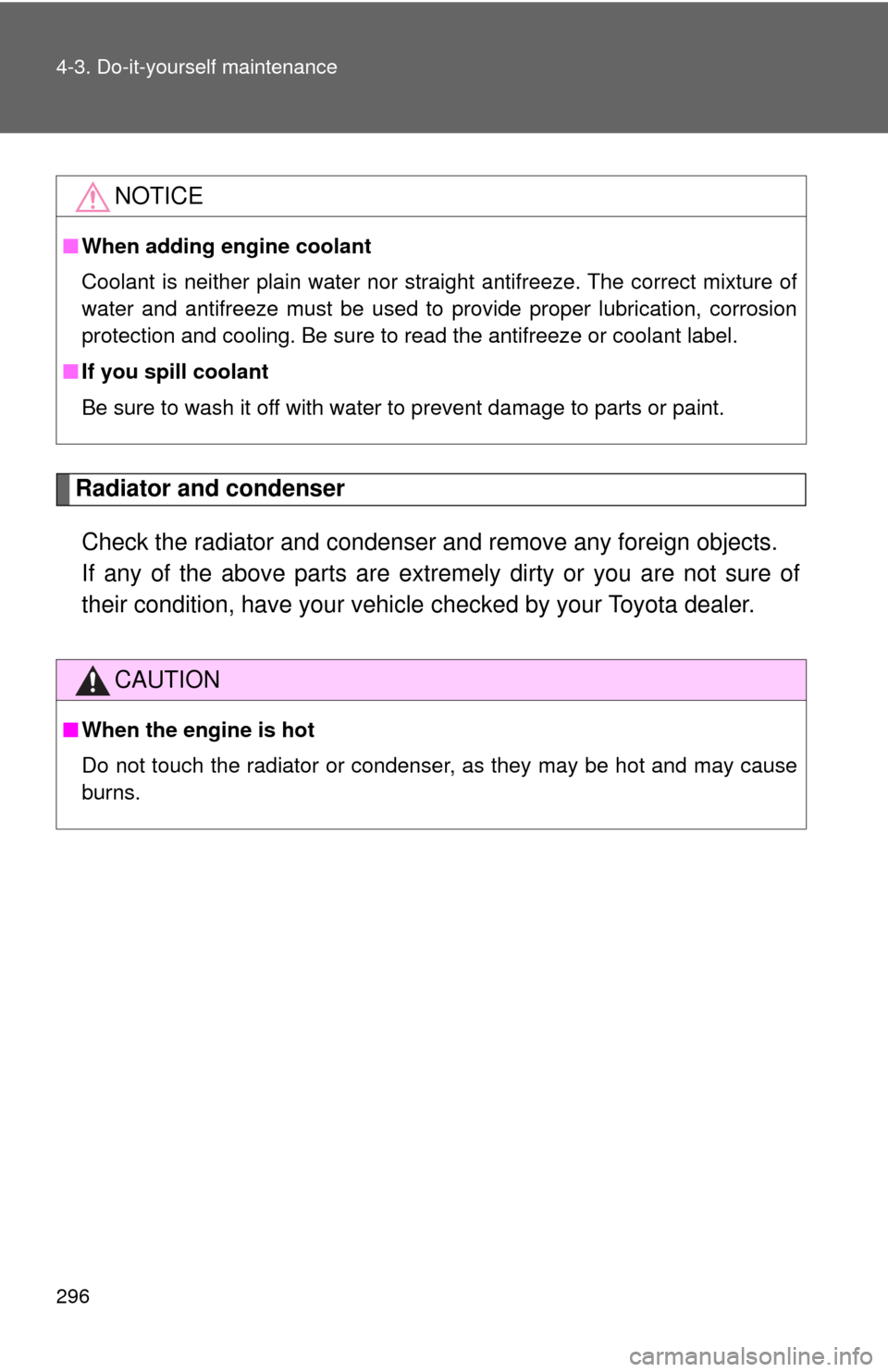
296 4-3. Do-it-yourself maintenance
Radiator and condenser
Check the radiator and condenser and remove any foreign objects.
If any of the above parts are extremely dirty or you are not sure of
their condition, have your vehicle checked by your Toyota dealer.
NOTICE
■When adding engine coolant
Coolant is neither plain water nor straight antifreeze. The correct mixture of
water and antifreeze must be used to provide proper lubrication, corrosion
protection and cooling. Be sure to read the antifreeze or coolant label.
■If you spill coolant
Be sure to wash it off with water to prevent damage to parts or paint.
CAUTION
■When the engine is hot
Do not touch the radiator or condenser, as they may be hot and may cause
burns.
Page 348 of 440
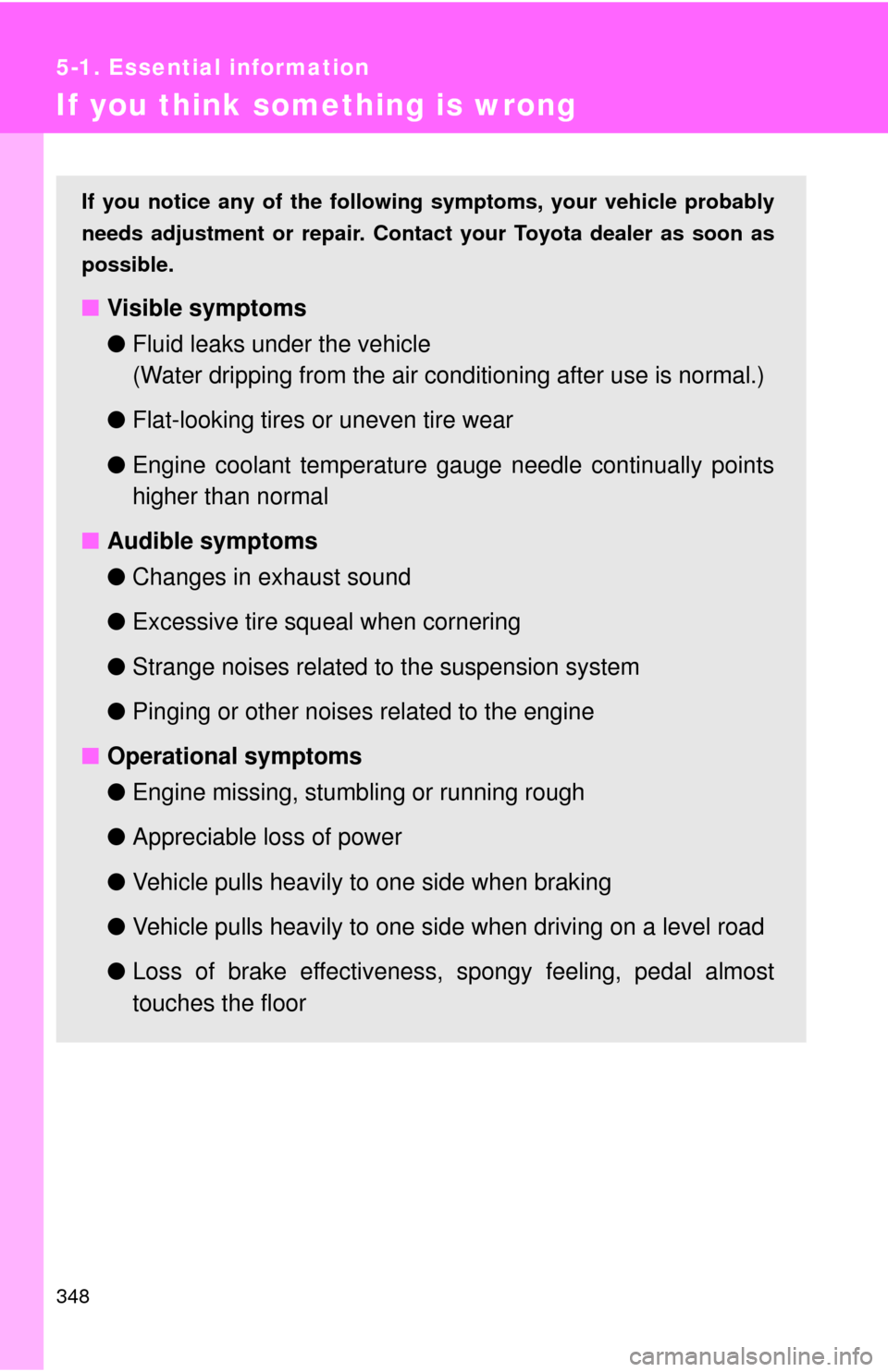
348
5-1. Essential information
If you think something is wrong
If you notice any of the following symptoms, your vehicle probably
needs adjustment or repair. Contact your Toyota dealer as soon as
possible.
■Visible symptoms
●Fluid leaks under the vehicle
(Water dripping from the air conditioning after use is normal.)
●Flat-looking tires or uneven tire wear
●Engine coolant temperature gauge needle continually points
higher than normal
■Audible symptoms
●Changes in exhaust sound
●Excessive tire squeal when cornering
●Strange noises related to the suspension system
●Pinging or other noises related to the engine
■Operational symptoms
●Engine missing, stumbling or running rough
●Appreciable loss of power
●Vehicle pulls heavily to one side when braking
●Vehicle pulls heavily to one side when driving on a level road
●Loss of brake effectiveness, spongy feeling, pedal almost
touches the floor
Page 385 of 440

5
When trouble arises
385
5-2. Steps to take in an emergency
If your vehicle overheats
If your engine overheats:
Stop the vehicle in a safe place and turn off the air condi-
tioning system.
Check to see if steam is coming out from under the hood.
If you see steam:
Stop the engine. Wait until the steam subsides, and then
carefully lift the hood.
If you do not see steam:
Leave the engine running and carefully lift the hood.
Check to see if the cooling fans are operating.
If the fans are operating:
Wait until the temperature of the engine (shown on the
instrument cluster) begins to fall and then stop the
engine.
If the fans are not operating:
Stop the engine and call your Toyota dealer.
After the engine has cooled
down sufficiently, check the
engine coolant level and
inspect the radiator core (radi-
ator) for any leaks.STEP1
STEP2
STEP3
STEP5STEP4
Page 386 of 440
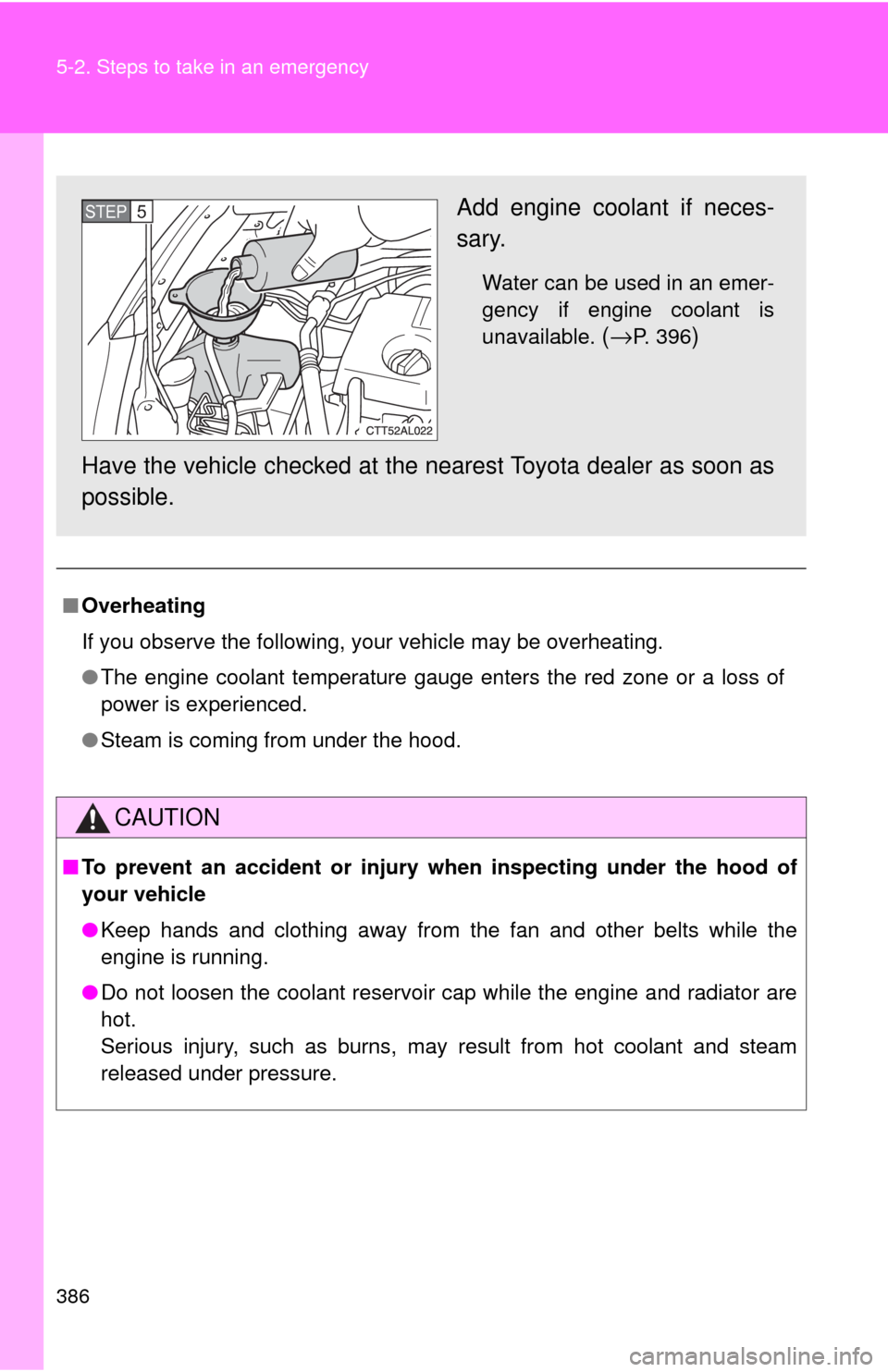
386 5-2. Steps to take in an emergency
■Overheating
If you observe the following, your vehicle may be overheating.
●The engine coolant temperature gauge enters the red zone or a loss of
power is experienced.
●Steam is coming from under the hood.
CAUTION
■To prevent an accident or injury when inspecting under the hood of
your vehicle
●Keep hands and clothing away from the fan and other belts while the
engine is running.
●Do not loosen the coolant reservoir cap while the engine and radiator are
hot.
Serious injury, such as burns, may result from hot coolant and steam
released under pressure.
Add engine coolant if neces-
sary.
Water can be used in an emer-
gency if engine coolant is
unavailable.
(→P. 396)
Have the vehicle checked at the nearest Toyota dealer as soon as
possible.
STEP5
Page 387 of 440

5
When trouble arises
387 5-2. Steps to take in an emergency
NOTICE
■When adding engine coolant
Wait until the engine has cooled down before adding engine coolant.
When adding coolant, do so slowly. Adding cool coolant to a hot engine too
quickly can cause damage to the engine.
Page 396 of 440
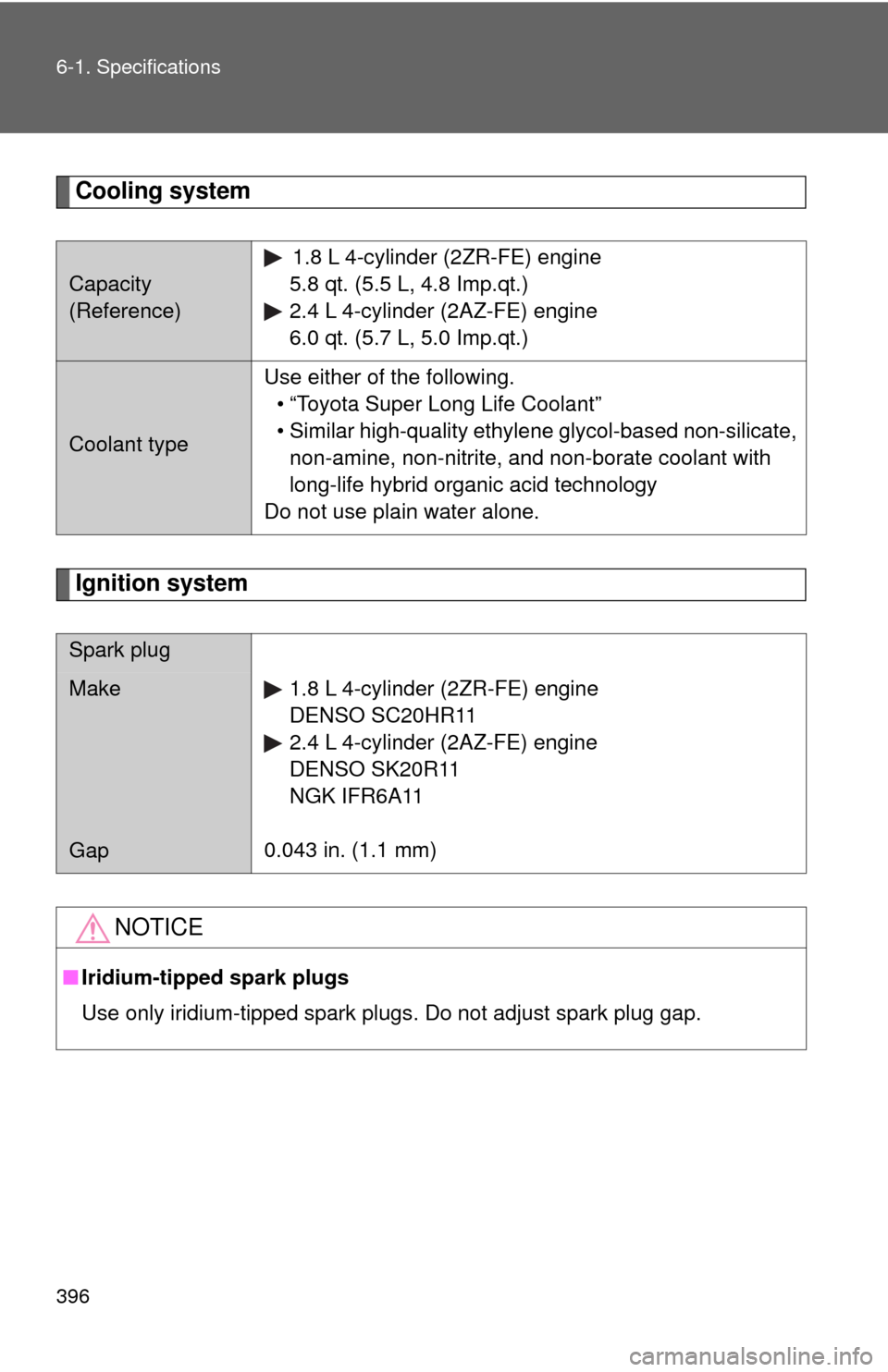
396 6-1. Specifications
Cooling system
Ignition system
Capacity
(Reference)1.8 L 4-cylinder (2ZR-FE) engine
5.8 qt. (5.5 L, 4.8 Imp.qt.)
2.4 L 4-cylinder (2AZ-FE) engine
6.0 qt. (5.7 L, 5.0 Imp.qt.)
Coolant typeUse either of the following.
• “Toyota Super Long Life Coolant”
• Similar high-quality ethylene glycol-based non-silicate,
non-amine, non-nitrite, and non-borate coolant with
long-life hybrid organic acid technology
Do not use plain water alone.
Spark plug
Make
Gap1.8 L 4-cylinder (2ZR-FE) engine
DENSO SC20HR11
2.4 L 4-cylinder (2AZ-FE) engine
DENSO SK20R11
NGK IFR6A11
0.043 in. (1.1 mm)
NOTICE
■Iridium-tipped spark plugs
Use only iridium-tipped spark plugs. Do not adjust spark plug gap.
Page 414 of 440
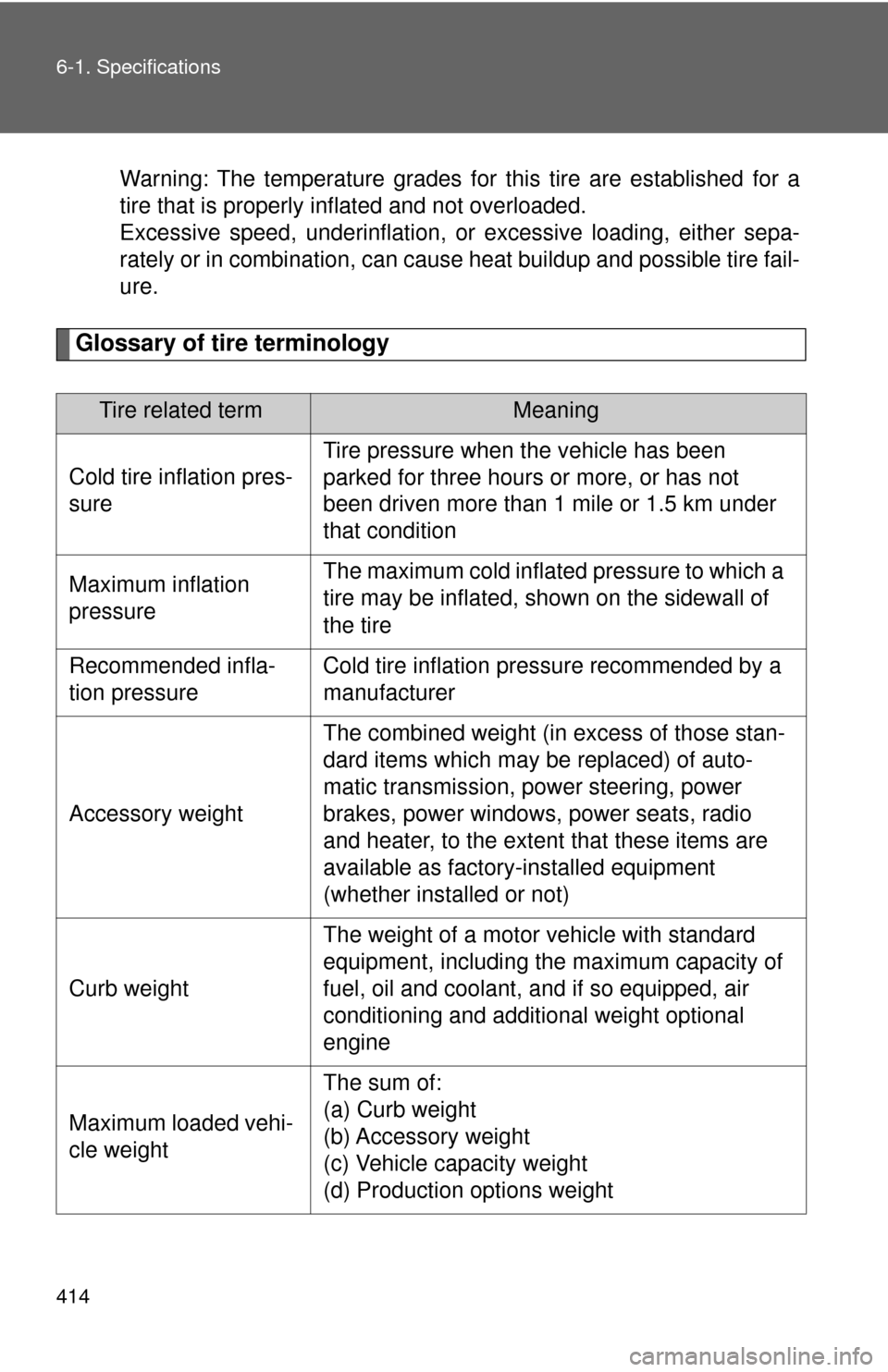
414 6-1. Specifications
Warning: The temperature grades for this tire are established for a
tire that is properly inflated and not overloaded.
Excessive speed, underinflation, or excessive loading, either sepa-
rately or in combination, can cause heat buildup and possible tire fail-
ure.
Glossary of tire terminology
Tire related termMeaning
Cold tire inflation pres-
sureTire pressure when the vehicle has been
parked for three hours or more, or has not
been driven more than 1 mile or 1.5 km under
that condition
Maximum inflation
pressureThe maximum cold inflated pressure to which a
tire may be inflated, shown on the sidewall of
the tire
Recommended infla-
tion pressureCold tire inflation pressure recommended by a
manufacturer
Accessory weightThe combined weight (in excess of those stan-
dard items which may be replaced) of auto-
matic transmission, power steering, power
brakes, power windows, power seats, radio
and heater, to the extent that these items are
available as factory-installed equipment
(whether installed or not)
Curb weightThe weight of a motor vehicle with standard
equipment, including the maximum capacity of
fuel, oil and coolant, and if so equipped, air
conditioning and additional weight optional
engine
Maximum loaded vehi-
cle weightThe sum of:
(a) Curb weight
(b) Accessory weight
(c) Vehicle capacity weight
(d) Production options weight
Page 431 of 440

431 Alphabetical index
Daytime running light
system ................................... 126
Defogger
Rear window......................... 168
Side mirror ............................ 168
Dimension ................................ 390
Dinghy towing .................. 156,157
Display
Trip meter ............................. 119
Do-it-yourself maintenance .... 279
Doors
Door glasses .......................... 51
Door lock .......................... 26, 29
Side mirrors ............................ 49
Driver's seat belt reminder
light ........................................ 355
Driving
Break-in tips ........................... 98
Correct posture....................... 63
Procedures ............................. 96
Winter driving tips ................. 144
Electric power steering........... 135
Emergency, in case of
If a warning light turns on ..... 352
If the engine will not start...... 376
If the shift lever cannot be
shifted from P ..................... 377
If the vehicle has a
discharged battery ............. 379
If the warning buzzer
sounds ............................... 352If you have a flat tire .............362
If you lose your keys .............378
If you think something is
wrong ..................................348
If your vehicle becomes
stuck ...................................388
If your vehicle needs to be
towed ..................................342
If your vehicle overheats .......385
Engine
Compartment ........................288
Engine switch ........................106
Hood......................................283
How to start the
engine .................................106
Identification number .............391
If the engine will not start ......376
Ignition switch........................106
Overheating...........................385
Engine coolant
Capacity ................................396
Checking ...............................295
Preparing and checking before
winter ..................................144
Engine coolant temperature
gauge ......................................119
Engine immobilizer system.......60
Engine oil
Capacity ................................395
Checking ...............................290
Preparing and checking before
winter ..................................144
Engine oil maintenance
data .........................................293
EPS ............................................135
Event data recorder .................350D
E
Page 438 of 440
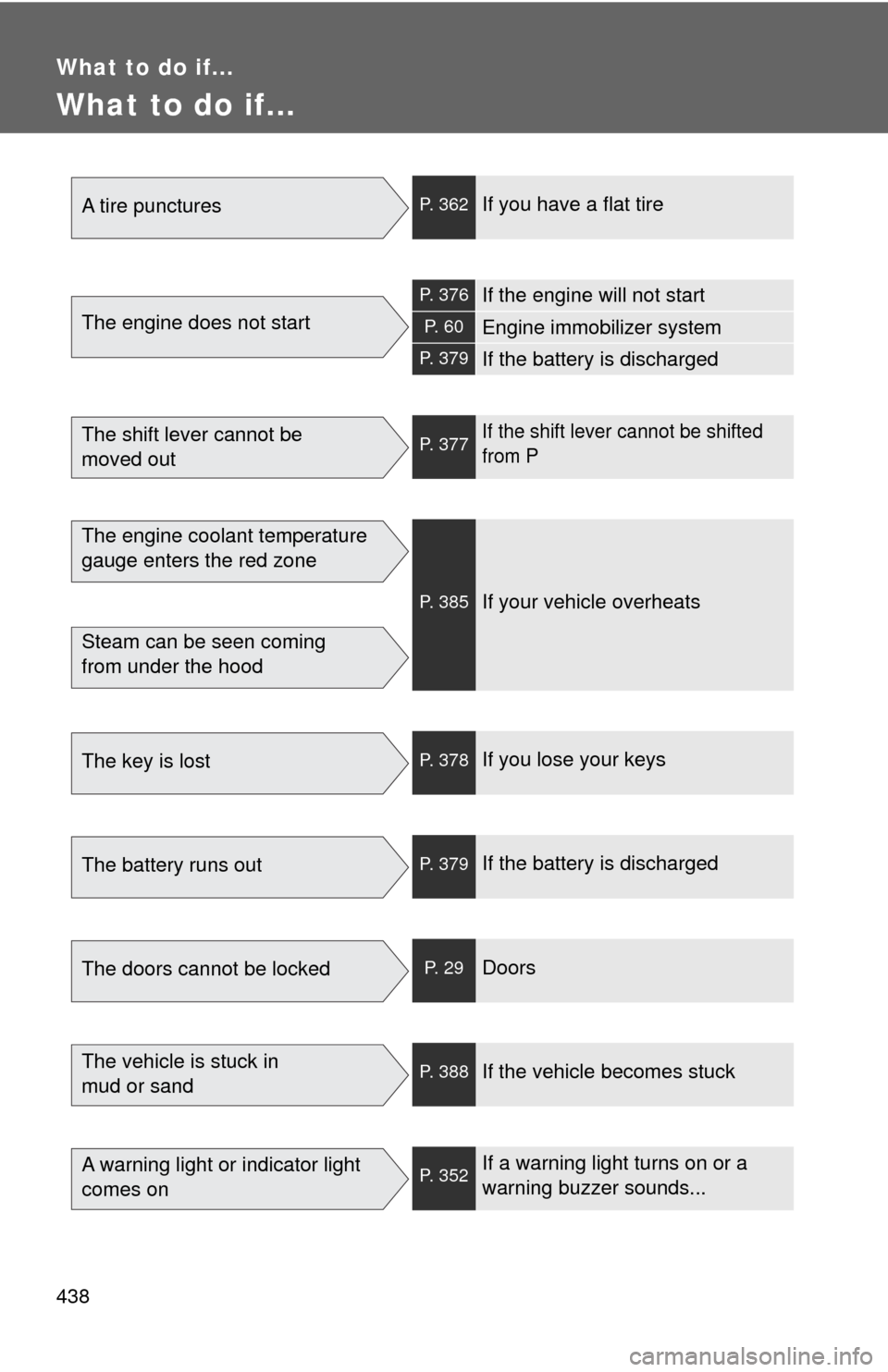
438
What to do if...
What to do if...
A tire puncturesP. 362If you have a flat tire
The engine does not start
P. 376If the engine will not start
P. 6 0Engine immobilizer system
P. 379If the battery is discharged
The shift lever cannot be
moved outP. 377If the shift lever cannot be shifted
from P
The engine coolant temperature
gauge enters the red zone
Steam can be seen coming
from under the hood
P. 385If your vehicle overheats
The key is lostP. 378If you lose your keys
The battery runs outP. 379If the battery is discharged
The doors cannot be lockedP. 2 9Doors
The vehicle is stuck in
mud or sandP. 388If the vehicle becomes stuck
A warning light or indicator light
comes onP. 352If a warning light turns on or a
warning buzzer sounds...